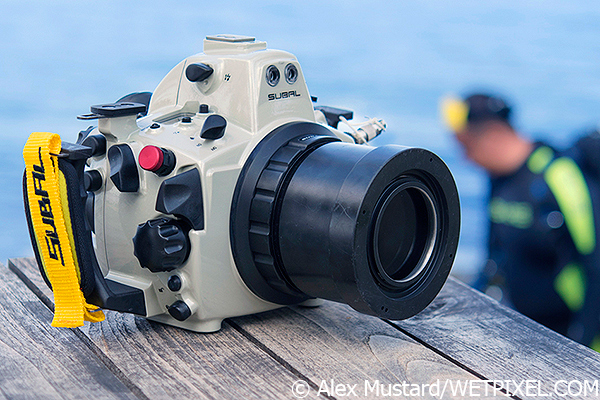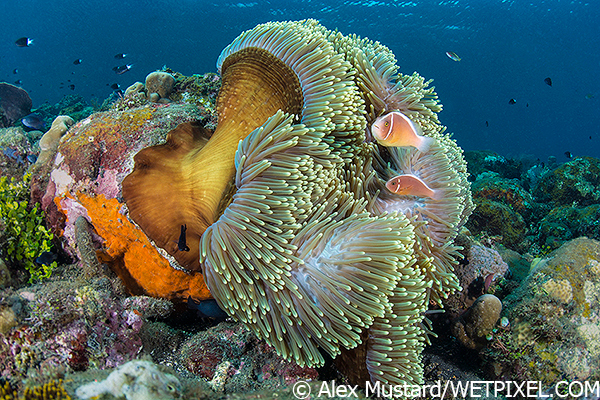Field review: Nikon D7100 and Subal ND7100

Field review: Nikon D7100 and Subal ND7100
By Alex Mustard.
Introduction
Since the first housings were made for Nikon Digitial SLRs, I’ve always tried to review the important releases as soon as possible. When the Nikon D7000 went on sale we had a detailed underwater review on Wetpixel before even the likes of DPReview had published a review on using the camera on land. Nikon’s current DX flagship went on sale in March and it is now December. Does our apathy speak volumes? Don’t be mislead, while the D7100 doesn’t bring much new technology it does blend some choice features into a small and aggressively priced camera body. In design, evolution is often better than revolution. This is Nikon’s best ever DX body.

Most serious underwater photographers don’t need convincing about the merits of the smaller DX format. DX means smaller cameras, smaller housings and the option of travel friendly mini-domes. It also means versatile lenses, like the Tokina 10-17mm fisheye zoom, highly suited to underwater subjects and underwater shooting where you can’t change a lens during a dive. Furthermore, DX gives more depth of field for any given subject magnification in macro shooting and for similar reasons, better corner sharpness in wide angle photography. Portrait photographers make a big fuss about the shallow depth of field of FX cameras, but underwater we don’t often use shallow depth of field and when we do it is easily achieved with our macro lenses, without even opening up all the way.

The Nikon D300 was introduced over six years ago and people still tell me that they are waiting for its direct replacement, a D400. This camera should have appeared three years ago! The D200 lasted less than 3 years, on that time scale the D300 should have been replaced twice by 2013!
Instead, Nikon seem to have done away with a fully pro-spec DX camera and given us the D7000 and now the D7100. My heart may want a D400, but my head looks at the D7100, which is so full of pro features, and finds it hard to see room for a D400. The D300 user is now left with a simple choice when upgrading: the DX D7100 or FX D800. This review will look at the D7100 in terms of its DX Nikon predecessors, as well as the alternative choice, the FX D800.

Nikon D300 users tend to look down their noses at the D7000 and D7100, which don’t have the tank like build of their camera. But is this a wise attitude for an underwater photographer? I travelled to Bali to judge the inaugural Indonesian World Underwater Photography Competition (IWUPC), and to help dish out the $200,000 USD cash prizes of “the world’s richest underwater photography contest, held on the world’s richest reefs”. Amongst the other esteemed judges were well-known industry big hitters: Burt Jones, Keri Wilk and Matt Weiss. All three were shooting Nikon D7000 cameras (in Subal, Aquatica and Nauticam housings). I mention this for those D300 owners who think the D7000/D7100 series is not good enough for them…

The D7100 costs from just $1100 USD (the D800 is almost three times more at $2800 USD: source B&H Photo), but clearly punches above its weight. Nikon will tell you that the camera has already scooped both the TIPA 2013 award for the best advanced DSLR and the EISA award for the European Camera of the Year. DPReview say it comfortably outpaces its direct competitors from Canon, Sony and Pentax and, compared with the D800, say if you “have no need for 36MP output, the D7100 offers a largely similar shooting experience, great looking images and a smaller, lighter body to carry”.
I tested the AF back to back with the D800 and could not tell any difference (while I do see a difference between the D800 and D4 and a big difference between D800 and D600/D610). The D7100’s 24MP DX sensor, not only out resolves that in Canon’s excellent 5D Mk3, it also out scores it in DXO’s tests. I decided not to mention this to Wetpixel’s Drew Wong (Mk3 shooter and DXO disliker), who I was diving with in the first part of my stay! In short, I was excited to get the camera to Bali, house it in Subal’s ND7100 and see what it could do. As always this is a lengthy review, which I know is always appreciated by those contemplating the sizeable investment involved in taking this camera underwater.

FTC Disclosure: The Nikon D7100 is my own camera. The Subal ND7100 housing was lent to me for the shoot. Unfortunately Subal did not send me a mini-dome or zoom gear for my Tokina 10-17mm, so I was not able to test this important combo. I am grateful to Alex Tattersall of Underwater Visions for sorting me out with a few smaller items that made the system work. I stayed at Scuba Seraya Resort before the IWUPC judging and moved to Mimpi Tulamben for the remainder of my visit.